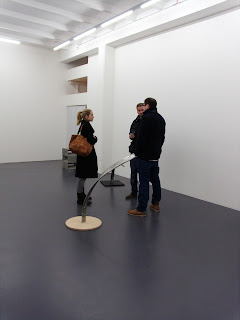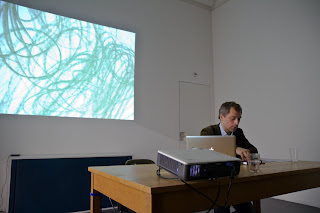
Jeroen Jacobs addresses with his sculptures the energy of the sculptural gesture and the potential of the materials used. Coincidence, the incalculable and the unfinished are central aspects in his work. His concrete sculptures are not developed from fixed molds, but from casts resulting from the attempt to grasp the empty spaces between found objects. Poured into only partly closed molds, the material is challenged to autonomy as the brittle concrete seeks its shape. The result is organic, negative forms whose final appearance is only partially controlled by the artist. The notion of negative or liminal space and confrontation with the materials and their characteristics are frequent themes in Jacobs’ work. In Tea Time (Autocenter, Berlin, 2010) he arranged found objects such as foam mats, rubber tires and pieces of wood into formally reduced sculptures, which he distributed throughout the space in tubes made from sheets of transparent PVC. In the double exhibition Lost and Found (with Tony Just at Sommer & Kohl, Berlin, 2009) he detached self-constructed table frames from their customary purpose and form by mounting them on the wall. With simple interventions, Jacobs dismantles, re-forms and exposes objects in space.
With JJ, the artist presents his newest work group at OSLO10. The exhibition title derives from a hammer stamped with the artist’s initials, which he received from his father when he commenced his studies of fine art. Taken aback by a series of personal connections related to this tool that he has used over the years, Jacobs began wielding the hammer on a series of steel and aluminum pipes. The continuous rhythmic blows that create indentations on the pipes are what determine the formation process, which the sculptor controls only as long as he can withstand the density of the material. The mutation of the pipes presents a transformed expression of physical force, examining the material’s inherent potential. The near-extreme restraint Jacobs uses in their formation is carried over into the presentation of the metal pipes. He lets them reach vertically while mounted on flat bases of partly painted wood that seem hardly to have been processed. A tension builds between the sculptures as absolute restraint meets a visibly intentional discharge of energy, force and movement.
In addition to the five steel sculptures, Jacobs presents a modular structure made of poured concrete blocks. For the exhibition Neue Heimat at Berlinische Galerie (2007) the artist created a wall within the space from concrete blocks. While the blocks are shaped like industrially produced concrete blocks, they are cast by hand. Jacobs again subverts the clear, straight form of the wall by intentionally allowing the inconsistencies and mistakes that occur during manual concrete casting. At OSLO10 he layers the blocks into cubes, offering a counterpoint in their closed form to the seemingly light, bent steel pipes, and thus achieving an impressive juxtaposition of his materials and the possible ways in which they may be processed.
Jeroen Jacobs (*1968, the Netherlands) lives and works in Berlin. The work cycle JJ was presented in January 2012 at Galerie Sommer & Kohl, Berlin. In recent years his works have been shown in solo and group exhibitions, including at Berlinische Galerie, Georg-Kolbe-Museum, Kunstraum Kreuzberg /Bethanien, Autocenter and NGBK in Berlin, as well as at Cacaofabriek in Helmond (NL). In Switzerland, Jacobs has been a part of group exhibitions at Projektraum exex, St.Gallen (2007), Galerie Arndt & Partner, Zurich (2006) and Kunsthalle Liestal (2001). OSLO10 presents the artist’s first solo exhibition in Switzerland.

Photos: Serge Hasenböhler
In her artistic work Nuri Koerfer pursues an ongoing interest in objects and forms and how they can present anthropomorphic movements. Her sculptures, drawings and collages derive from transformations of everyday structures that she transposes into her own visual language. Using the medium of collage, Koerfer often creates new combinations of everyday objects and furniture that reflect a delicate balance between a still recognizable function and free artistic form. Central elements of her sculptures include plinths, frames and shelves, through which she reflects the purposes and perspectives of displays and exhibition furniture. The artist combines these static presentation models with objects of fragile and instable materials such as paper maché, paraffin, wax, cardboard or masking tape, which then refer to real as well as fictitious motifs. In sculptures such as Untitled (Verfaulter Berg I - II) (2008) or Untitled (Der Gipfel) (2010), Koerfer presents on chair-like plinths objects that resemble amorphously shaped mountains. With humor approaching the surreal as well as the melancholic, the formations depict the decomposition of the stable rock or stone. Koerfer scrutinizes how process-oriented gestures and physical actions manifest themselves as traces or imprints in the medium of sculpture. Her works oscillate between utilitarian potential and an intentionally staged dysfunctionality reflecting society and its treatment of everyday objects and consumer goods.
In the current installation hold down, Nuri Koerfer presents four wooden sculptures with a collage series in a site-specific arrangement at OSLO10. The multi-part sculptures About Cool 1 - 4 are furniture-like instruments evoking support structures for poses exemplifying coolness. For the project, the artist researched gestures and poses related to the notion of ‘coolness’, which was popularized in the 1920s in New York in the context of the African American jazz scene. Since then, the term has been taken up by youth culture and vernacular to express a skeptical as well as rebellious attitude. Koerfer’s sculptures reflect physical poses of nonchalance and countenance that bear at the same time an element of self-defense and insecurity. The wooden structures display performative movement that is absent, but yet remaining preserved in their spatial displayed coordinates.
In Hold Down The Starring Sticks, a series of inkjet prints, the artist presents montages of film stills and photographs of pop culture idols from music and film such as David Bowie, Yves Saint Laurent, Jane Birkin and Glenn Gould. In search of a sense of “romantic coolness,” Koerfer focuses on their individual gestures, which she extracts and presents as reduced silhouettes. The collages have as their background an image of a recycling rubber mat that has been scanned, enlarged and printed on aluminum. The pixelated pattern is echoed in the identical material upon which the wooden sculptures are mounted. The artist thus brings together the individual elements of the spatial setting into an ensemble uniting form and content, reflecting concentrated observations of interpersonal nonverbal communication.
Nuri Koerfer (*1981, Switzerland, lives in Berlin and Zurich) studied art from 2001 to 2004 at Byam Shaw School of Fine Art in London. For six months in 2008 she worked in Kunming, China in conjunction with an artist grant from Helmhaus Zurich. From January to March 2011 she took part in the Mountain School of Art in Los Angeles. She presented her works in exhibitions e.g. 2007 in Nuri Koerfer / Sandy Kozjek at Freymond-Guth, Zurich; 2008 in the group exhibition Walking on Thin Ice, Artnews Projects, Berlin; 2009 in Auction 2009 at the Swiss Institute, New York; 2011 in the groupexhibition Search & Destroy, Galerie Mikael Andersen, Berlin and Hidden-Parts at After the Butcher, Berlin; and in 2011 in the solo exhibition hold down at Galerie Loock, Berlin.
Photos: Serge Hasenböhler
Opening hours of the exhibition until 29.04.2012:
THU – SAT, 2 – 6pm
Closed: 06.04.2012 - 11.04.2012






















































